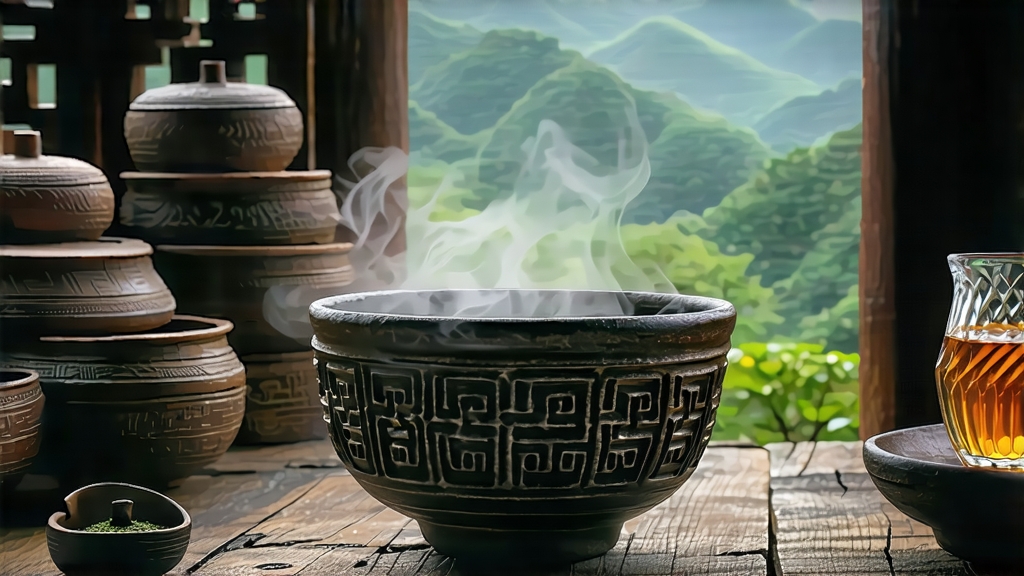
Tucked away in the subtropical mountains of southern China, Liu Bao Cha has quietly matured for over fifteen centuries, yet it remains the least-known member of the dark-tea family among global tea lovers. While Pu-erh commands auction headlines and Fu Zhuan bricks delight with their golden “flowers,” Liu Bao continues to be the insider’s secret—a tea that once fueled the porters of the ancient Tea-Horse Road and still fuels the dawn dim-sum halls of Guangzhou today. To understand Liu Bao is to witness how time, humidity, and microbial artistry can turn a simple leaf into a mellow, medicinal liquor that tastes of damp earth, betel nut, and long-forgotten camphor chests.
History: From Border Town to World Expo
Liu Bao village lies in Cangwu County, Wuzhou Prefecture, Guangxi Zhuang Autonomous Region. Records from the Tang Dynasty (618-907 CE) already mention “Yue tea” being bartered for horses in the nearby markets, and by the Qing (1644-1912) the tea had acquired its present name. In the late nineteenth century, Liu Bao was loaded onto bamboo rafts, floated down the Liu-jiang River to the Pearl River, and then transshipped to Hong Kong and Southeast Asia where miners and dockworkers prized it for dissolving the grease of a diet heavy in lard and rice. The 1886 issue of the Hong Kong Daily Press even carried an advertisement for “Liu Pau—cooling, slimming, five cents a bowl.” The tea’s international moment arrived in 1889 when it won a gold medal at the Paris World Exposition; yet, paradoxically, the same maritime trade routes that spread it abroad also caused it to be overshadowed by the more aggressively marketed Yunnan Pu-erh.
Raw Material & Leaf Style
Liu Bao is made from a local large-leaf cultivar, Camellia sinensis var. sinensis f. pubilimba, notable for thick, leathery leaves covered in fine down. Farmers pick one bud with three to four leaves in late April, when the spring rains end and the leaf’s cellulose is still tender enough to ferment thoroughly. The harvested material is spread into “water fields”—bamboo trays set on outdoor racks—where it wilts under a combination of mountain mist and direct sun, a duality that jump-starts enzymatic oxidation while preserving a green core.
Crafting: The Six Acts of Transformation
- Kill-green: 10–12 min in a 200 °C drum pan halts oxidative enzymes yet keeps interior moisture above 62 %.
- Rolling: 55 min of light pressure ruptures cell walls without breaking veins, forming the tight, rope-like strips that will later trap humidity.
- Pile-fermentation: Unique among dark teas, Liu Bao undergoes a primary 10- to 18-hour wet piling at 60–65 °C. Workers cover the leaves with wet gunny sacks and turn them every 30 min, encouraging the rise of Bacillus subtilis and Aspergillus niger, microbes that pre-digest tannins and create the tea’s hallmark “betel-nose” aroma.
- Drying: Instead of wood-fired ovens, traditional workshops dry the piles on bamboo racks above charcoal braziers fueled by longan wood, imparting a whisper of fruit-sweet smoke.
- Basket aging: While still warm, the semi-dry tea is hand-pressed into 40–50 kg rattan baskets lined with untreated banana leaf. The baskets are stacked in humid, poorly ventilated cellars where relative humidity hovers at 75–85 %. Over months, the tea “sweats,” re-absorbing ambient moisture and continuing microbial fermentation.
- Post-fermentation rest: After one year, the baskets are moved to mountain caves or modern climate-controlled warehouses for a minimum of three additional years. Vintage lots (15–30 years) develop white, frost-like crystalline blooms of amino-acid complexes—mistaken by novices for mold but cherished by connoisseurs as “silver frost.”
Grades & Shapes
Traditional Liu Bao is sold by basket weight: 30 kg “small basket,” 40 kg “medium,” and 50 kg “large.” Inside, the leaf is further graded:
- First grade: golden tips visible, liquor honey-smooth.
- Third grade: balanced stems, classic camphor note.
- Fifth grade